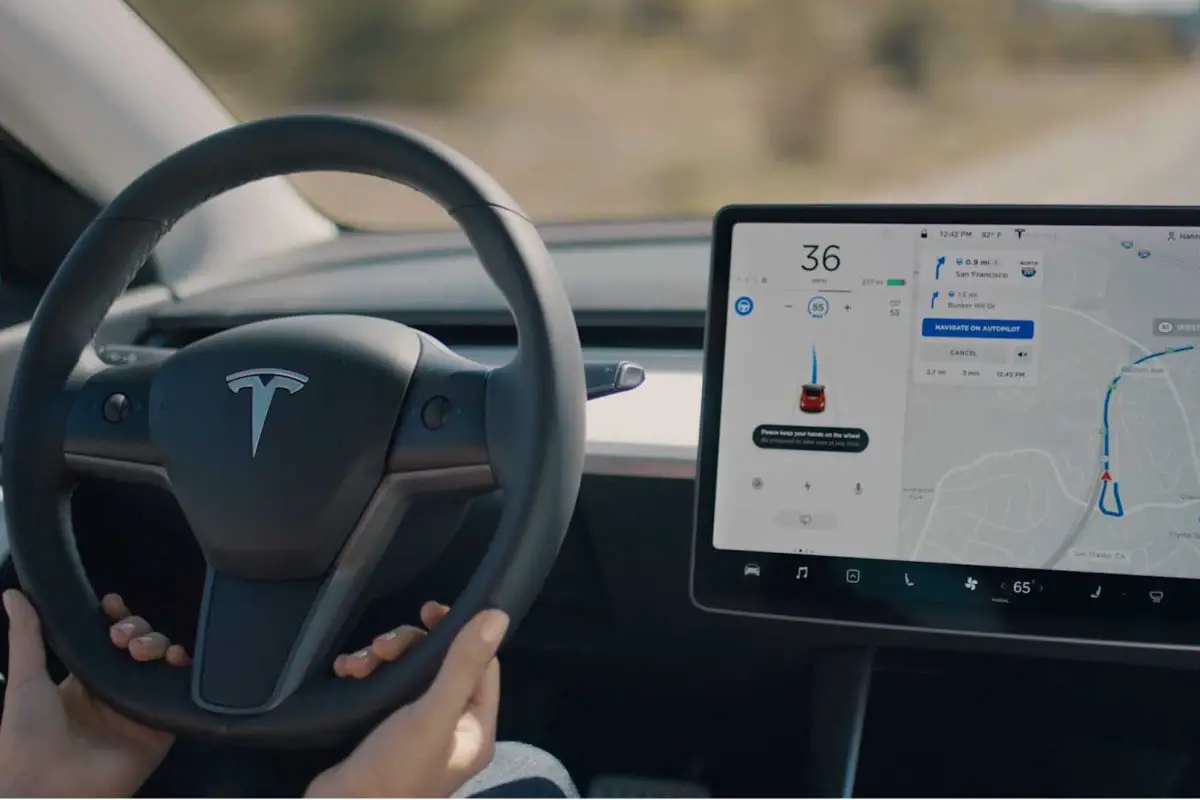Tesla’s autopilot system was arguably the first major road-going self-driving application. While you must touch the steering wheel often to let the car know you’re alert, it’ll take control of steering, acceleration, and brakes.
Autopilot on the Model S can be turned on in any road-going circumstance. However, it’s best used in stop-start traffic. Here, the risks of something going wrong are much lower. Plus, it helps navigate all those dull delays.
Before using Autopilot, read through your owner’s manual thoroughly! It contains everything you need to know, including detailed information about the risks involved.
Table of Contents
What Is Tesla Autopilot?
It’s really a combination of several systems. These include:
- Traffic-Aware Cruise Control – controlling your speed and taking other vehicles into account.
- Autosteer – turning the steering wheel to direct your Tesla. Clearly-defined lane edges are vital.
Enhanced Autopilot also involves: - Navigate on Autopilot – this allows the car to use Autopilot to get to your navigation system’s destination.
- Traffic Light and Stop Sign Control – slows you down and stops you when approaching stop signs or traffic lights.
- Autopark – the Tesla will park itself for you (perpendicular or parallel).
- Summon and Smart Summon – the Model S rolls itself out of its parking space. This makes getting in easier. With Smart Summon, it’ll maneuver slowly around the parking lot to find you.
How Does It Work?
The Model S’s Autopilot works using a considerable number of cameras and other sensors (sonar and radar).
- Radar (if applicable) on the front bumper
- Ultrasonic sensors on the front and rear
- Two cameras on each front fender
- Three cameras on the windshield
- One camera per door pillar
- One camera above the rear licence plate
Collectively, these sensors give the car the information it needs to drive using Autopilot.
Before Activating Tesla Model S Autopilot…
Before you can activate Autopilot, the cameras and sensors must calibrate. If you’ve bought the car new, the cameras have been adjusted, or it’s had a factory reset, you’ll need to do this.
- It should take about 20 to 25 miles for calibration to complete.
- You’ll see a progress bar on the screen.
- Use large, wide highways with multiple clearly-defined lanes.
- If calibration hasn’t finished after 100 miles of driving, contact Tesla.
Adjusting The Settings Before Activating Autopilot On The Tesla Model S
- Look to the central touchscreen and select Controls.
- Now, choose Autopilot.
Here, you can adjust all the automatic settings. For example, under Set speed, you can choose whether Autopilot will engage at your current speed or the speed limit.
You can also set an Offset from the speed limit – either numerical or percentage. This allows you to travel slightly above or below the road’s maximum.
Play around. There are many things to look at.
How To Activate Tesla Model S Autopilot
- Pull the cruise control stalk in your direction twice, quickly.
- A blue steering wheel icon appears on your display. This signals that Autopilot is activated.
The car will now travel at a set speed, turning the wheel for slight bends in the road.
How To Make Traffic-Aware Cruise Control Stick To The Speed Limit
- The Tesla recognizes this information when you go past a speed limit sign.
- Pull and hold the cruise control stalk.
- Release the accelerator pedal.
- The speed will adjust to the speed limit (+/- your Offset).
How To Deactivate Autopilot On The Tesla Model S
- Touch the brake (like cruise control), or
- Press the silver button on the end of the cruise control stalk.
Limitations On The Model S Autopilot System
Like everything, there are limitations. You must be extremely careful when using Autopilot. It’s not yet a complete self-driving system!
- Dirt, debris, fog, snow, heavy rain, and more can obscure sensors and cameras. These could make it deactivate or behave unpredictably.
- Poorly-defined lane markings mean the Tesla doesn’t know where it is on the road.
- Autopilot might not work with sharp turns, sudden stops, or fast acceleration.
- Although it’s becoming rarer, a sensor might misread something. For example, the side of a semi has been misinterpreted as the sky before, causing a crash.
There are many more things to consider. Read the owner’s manual safety section before using Autopilot. Importantly, never switch off! Even when Autopilot is engaged, you must still be ready to react at a moment’s notice.
One last thing. The Autopilot will turn off if you don’t touch the steering wheel for too long! When it tells you to put slight input into the wheel, do so. If you don’t, eventually, it’ll lock you out of the system for the remainder of the journey.
Check out some of the Tesla Model S owner’s manual for yourself here.
